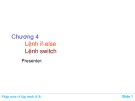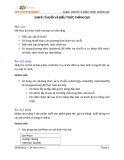
Trying Code and Catching Exceptions
C# makes it easy to separate the code that implements the main flow of the program from
the error handling code, by using exceptions and exception handlers. To write exception-
aware programs, you need to do two things:
1. Write your code inside a try block (try is a keyword). When the code runs, it
attempts to execute all the statements inside the try block, and if none of the
statements generates an exception, they all run, one after the other, to completion.
However, if an error condition occurs, execution jumps out of the try block and
into a catch handler.
2. Write one or more catch handlers (catch is a keyword) immediately after the try
block to handle any possible error conditions. If any one of the statements inside
the try block causes an error, the runtime generates and throws an exception. The
runtime then examines the catch handlers after the try block and transfers control
directly to a matching handler. Catch handlers are designed to trap particular
exceptions, allowing you to provide different handlers for the different errors that
can happen.
Here's an example that uses a try block to attempt to convert some text fields into integer
values, call a method to calculate a value, and write the result to a text field. Converting a
string to an integer requires that the string contains a valid representation and not some
arbitrary sequence of characters. If the string contains invalid characters, the Int32.Parse
method throws a FormatException, and execution transfers to the corresponding catch
handler. When the catch handler finishes, the program continues with the first statement
after the handler:
try
{
int leftHandSide = Int32.Parse(leftHandSideOperand.Text);
int rightHandSide = Int32.Parse(rightHandSideOperand.Text);
int answer = doCalculation(leftHandSide, rightHandSide);
result.Text = answer.ToString();
}
catch (FormatException fEx)
{
// Handle the exception
...
}
Handling an Exception

The catch handler uses syntax similar to that used by a method parameter to specify the
exception to be caught. In the previous example, when a FormatException is thrown, the
fEx variable is populated with an object containing the details of the exception. The
FormatException type has a number of fields that you can examine to determine the exact
cause of the exception. Many of these fields are common to all exceptions. For example,
the Message field contains a text description of the error that caused the exception. You
can use this information when handling the exception, recording the details to a log file,
or outputting a meaningful message to the user and asking them to try again, for example.
Unhandled Exceptions
What happens if a try block throws an exception and there is no corresponding catch
handler? In the previous example, it is possible that the leftHandSideOperand field
contains the string representation of a valid integer, but the integer that it represents is
outside of the range of valid integers supported by C# (for example, “2147483648”). In
this case, the Int32.Parse statement will throw an OverflowException, which will not be
caught by the catch handler as it specifies that it catches FormatException. If the try
block is part of a method, the method finishes and returns to the calling method. If the
calling method uses a try block, the common language runtime attempts to locate a
matching catch handler after the try block and execute it. If the calling method does not
use a try block, or there is no matching catch handler, the calling method terminates and
returns to its caller where the process is repeated. If a matching catch handler is
eventually found, it runs and execution continues with the first statement after the catch
handler in the catching method.
IMPORTANT
Notice that after catching an exception, execution continues in the method containing the
catch block that caught the exception. Control does not return to the method that caused
the exception.
If, after cascading back through the list of calling methods, the common language
runtime is unable to find a matching catch handler, the program terminates with an
unhandled exception. If you are running the application in Visual Studio 2005 in Debug
mode (you selected Start Debugging in the Debug menu to run the application), the
following information dialog box appears and the application drops into the debugger,
allowing you to determine the cause of the exception:
Using Multiple catch Handlers
The previous discussion highlighted how different errors throw different kinds of
exceptions to represent different kinds of failure. To cope with these situations, you can
supply multiple catch handlers, one after the other, like this:

try
{
int leftHandSide = Int32.Parse(leftHandSideOperand.Text);
int rightHandSide = Int32.Parse(rightHandSideOperand.Text);
int answer = doCalculation(leftHandSide, rightHandSide);
result.Text = answer.ToString();
}
catch (FormatException fEx)
{
//...
}
catch (OverflowException oEx)
{
//...
}
Catching Multiple Exceptions
The exception-catching mechanism of the common language runtime is pretty
comprehensive. There are many different exceptions defined in the .NET Framework,
and any programs you write will be able to throw most of them! It is highly unlikely that
you will want to write catch handlers for every possible exception that your code can
throw. So how do you ensure that all possible exceptions are caught and handled?
The answer to this question lies in the way the different exceptions are related to each
other. Exceptions are organized into families called inheritance hierarchies (you will
learn about inheritance in Chapter 12, “Working with Inheritance”). FormatException
and OverflowException both belong to a family called SystemException, as do a number
of other exceptions. Rather than catching each of these exceptions individually, you can
create a handler that catches SystemException. SystemException is itself a member of a
family simply called Exception, which is the great-grandaddy of all exceptions. If you
catch Exception, the handler traps every possible exception that can occur.
NOTE
The Exception family includes a wide variety of exceptions, many of which are intended
for use by various parts of the common language runtime. Some of these are somewhat
esoteric, but it is still useful to understand how to catch them.
The next example shows how to catch all possible system exceptions:
try
{
int leftHandSide = Int32.Parse(leftHandSideOperand.Text);
int rightHandSide = Int32.Parse(rightHandSideOperand.Text);

int answer = doCalculation(leftHandSide, rightHandSide);
result.Text = answer.ToString();
}
catch (Exception ex) // this is a general catch handler
{
//...
}
TIP
If you wish to catch Exception, you can actually omit its name from the catch handler,
because it is the default exception:
catch { // ... }
However, this is not always recommended. The exception object passed in to the catch
handler can contain useful information concerning the exception, which is not accessible
when using this version of the catch construct.
There is one final question you should be asking at this point: What happens if the same
exception matches multiple catch handlers at the end of a try block? If you catch
FormatException and Exception in two different handlers, which one will run (or will
both execute)?
When an exception occurs, the first handler found by the common language runtime that
matches the exception is used, and the others are ignored. What this means is, if you
place a handler for Exception before a handler for FormatException, the
FormatException handler will never run. Therefore you should place more specific catch
handlers above a general catch handler after a try block. If none of the specific catch
handlers matches the exception, the general catch handler will.
In the following exercise, you will write a try block and catch an exception.
Write a try/catch statement
1. Start Visual Studio 2005.
2. Open the MathsOperators solution located in the \Microsoft Press\Visual CSharp
Step By Step\Chapter 6\MathsOperators folder in your My Documents folder.
This is a variation on the program that you first saw in Chapter 2, “Working with
Variables, Operators, and Expressions.” It was used to demonstrate the different
arithmetic operators.
3. On the Debug menu, click Start Without Debugging.
NOTE
If you run the application in Debug mode, it drops into the debugger when an

unhandled exception occurs. This is not what we want in this example, so ensure
that you click Start Without Debugging.
Visual Studio 2005 builds and runs the Windows application. The Exceptions
Form appears.
You are now going to deliberately enter some text that is not valid in the left
operand text box. This operation will demonstrate the lack of robustness in the
current version of the program.
4. Type John in the left operand text box, and then click Calculate.
A dialog box reports an unhandled exception; the text you entered in the left
operand text box caused the application to fail.
5. Click Details in the Exception dialog box to display the information concerning
the exception:
From the first few lines of text, you can ascertain that the exception was thrown by
the call to Int32.Parse inside the calculate_Click method.
6. Click Quit to close the Exceptions dialog box and return to Visual Studio 2005.
7. Display the code for the file Form1.cs in the Code pane.
8. Locate the calculate_Click method. Add a try block around the four statements
inside this method, so that the code looks exactly as follows:
9. try
10. {
11. int leftHandSide = Int32.Parse(leftHandSideOperand.Text);
12. int rightHandSide = Int32.Parse(rightHandSideOperand.Text);
13. int answer = doCalculation(leftHandSide, rightHandSide);
14. result.Text = answer.ToString();
}
15. Add a catch block after this new try block, as follows:
16. catch (FormatException fEx)
17. {
18. result.Text = fEx.Message;
}












![Câu hỏi trắc nghiệm Lập trình C [mới nhất]](https://cdn.tailieu.vn/images/document/thumbnail/2025/20251012/quangle7706@gmail.com/135x160/91191760326106.jpg)













